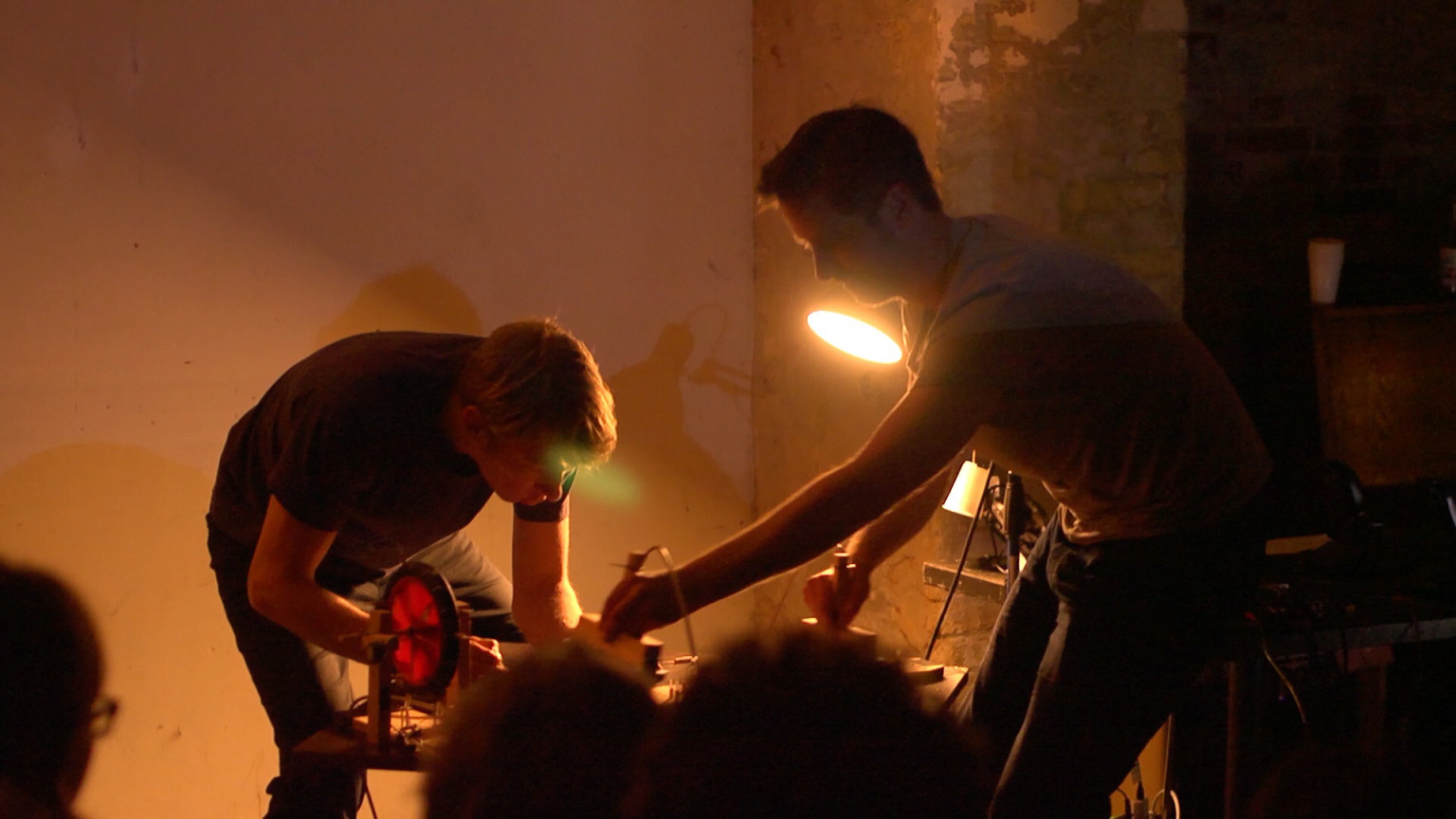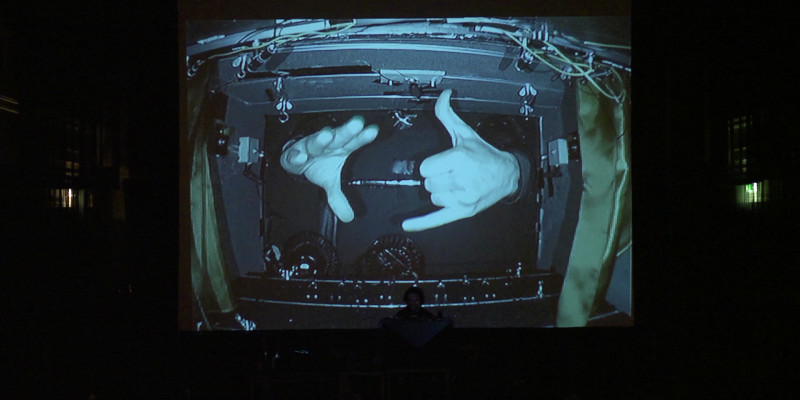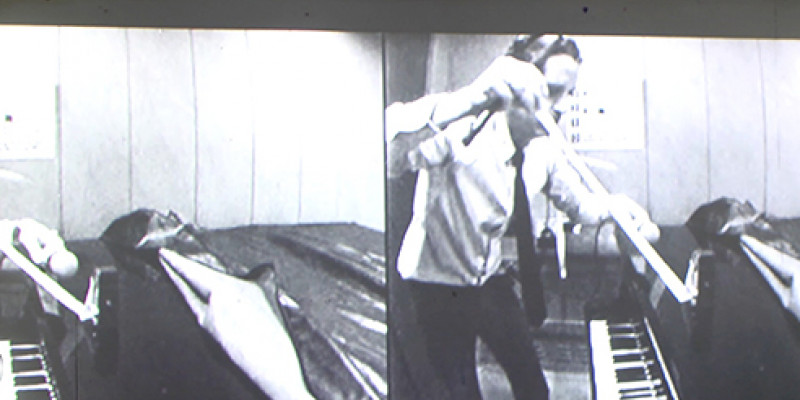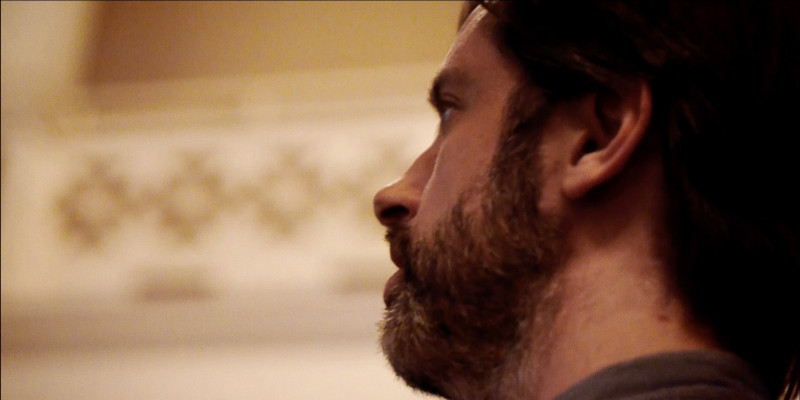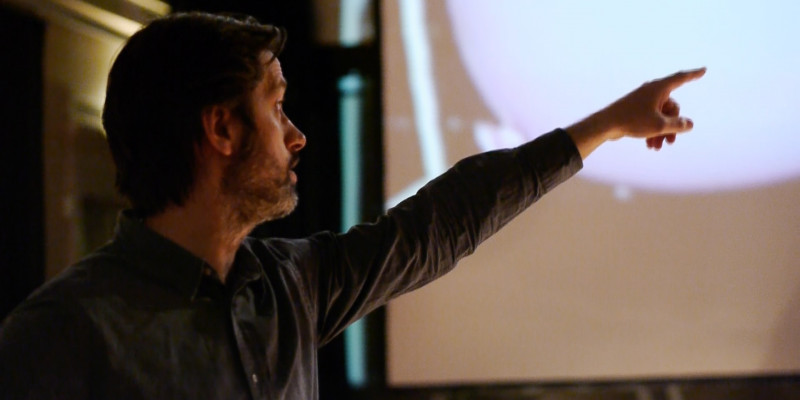These words take shape in a Swedish cabin. The summer is unusually warm and with the added heat of the computer screen, my usual discomfort at the beginning of a creative work seems doubled. I give in to this sense of resistance and in the company of my nephew, go balancing from stone to stone along the beach. His name is also Simon and this particular summer, he is part and parcel of his soccer kit, which matches that of the Brazilian team. The lake here is called Västra Silen. However, Simon believes it is West Brazil. I think he imagines the World Cup taking place at the end of the lake – 40 km south of here. Maybe he can hear echoes of fervent cheers in the quietude of nature. I choose not to ask him because I quite like the idea that the illusion is so closely related to the real and global spectacle. In the company of a little child, it is possible to shape the world as you see fit.
As is often the case with Simon Steen-Andersen, the basic idea of the work seems refined and well-founded.
Watching Simon Steen-Andersen play the building in Run Time Error resembles the way my nephew shapes his universe. The title of the work implies an error – more precisely a software error which one would usually try and fix. But this work is all about the creations that arise once the ‘program’ assumes its own life. It has its very own logic and apparently distinct rules; one being that whatever constitutes the composition’s instruments must be found inside the house. The work makes use of several fugal techniques: themes are exposed, developed, expanded and they meet their counterpoint. As is often the case with Simon Steen-Andersen, the basic idea of the work seems refined and well-founded. However, what grips my attention is the notion that new creations might spring out of a mistake.
Echoes of dust and breath
Steen-Andersen studied in Argentina and he carries some of this into his universe. In an older text about this country, which is declared bankrupt a second time while I write these lines, he describes how a number of Argentinean composers share a musical kinship with the Nordic countries, but they do not share the European structural elements like development, direction and climax.1 Instead they often practise restrained movements, verging on stillness.
He can call attention to echoes of dust and breath and find the sounds of the human behind them.
Steen-Andersen does the exact same thing. The following astounds me every time I listen to his music: that a man whose work is rounded by a thoroughly intellectual approach, where an idea is considered from every possible angle, also makes room for the quiet and the fragile. He can twist an instrument and search out its most delicate expression. He can call attention to echoes of dust and breath and find the sounds of the human behind them. Yet, however well-considered, the composer also finds room to evoke emotions and sensuality. A kind of patience, if you will, to stop and consider one element at a time. A presence, which makes me wish that I could write this text with less argument and more abstraction.
A perspective beyond the everyday
Steen-Andersen explores the paradox in the aforementioned text. He writes about the South Americans composing calm and transparent music as a contrast to their chaotic surroundings and everyday life, while the Europeans contrast ordered structures with chaotic and complex music. But then, the lack of linearity and structure that characterizes Valverde’s music seems to reflect his life and temper, while the complexity of European music could just as easily be seen as a reflection of an underlying hyperstructure.2 So, according to Steen-Andersen, one might regard music as a contrast, a reflection or even a caricature of the culture where it took shape – all are viable points of view.
‘Points of view’ as well as ‘perspectives’ are possibly my Norwegian teacher’s most used words. My generation has fully learnt to ask: who sees, who thinks, who has an agenda? We are critical of statements, we try to be aware of the preconceptions with which we approach art and examine the context that surrounds it. We can have all manner of opinions as long as we know how to substantiate them. This is the foundation for discussion in our present visual and technological era, but also how art acquires its meaning. The paradoxes of our generation can be found in a sort of tension where music has still more capable and specialized practitioners – all the while, the arts accelerate and still fewer know the older aesthetic canons. The competition is greater than ever and quality is also a relative matter.
His project is an intellectual one, but it is also intuitive. It is playful, yet precise. Free, but with strictly defined direction. Masterly but also fragile.
Following this line of thought, I end up analyzing Steen-Andersen’s music on the premise of the paradox. His project is an intellectual one, but it is also intuitive. It is playful, yet precise. Free, but with strictly defined direction. Masterly but also fragile. Easily understood while very complex. And, most importantly to this listener, it holds a simple proposal, inviting us to widen our vision beyond the everyday and momentarily lend ourselves to a child’s perspective.
It sounds with ambiguity
“I choose music and all that comes with it”, SSA writes in a debate somewhere.3 “I choose music and all it involves – cutting across experience, thinking, reaction and discussion “. By adding multiple layers and directions to the music he induces the listener to intimacy, active participation, and to shift between ways of listening and experiencing. “I am very interested in the idea that a piece of music does not necessarily need to be self-enclosed, but rather can remain open-ended, unfulfilled and ambiguous and continue to reverberate after its completion.”4
This is a democratic thought completely in line with our time and especially the composer’s own generation.
This is a democratic thought completely in line with our time and especially the composer’s own generation. Who becomes a composer today? Our contemporaries have been able to ‘do it yourself’ and that is exactly what they have done; we release our own material, program our own concerts, make statements, blog and are experts in our own taste.
When we discuss art with performative elements - art as action, it is tempting to regard this, and indeed this generation’s entire work, as a modern mantra about sharing. In order to operate in this landscape and create art, which is intelligent but also induces this particular element of participation in the listener, a degree of transparency is needed. Steen-Andersen offers such through his simple but strong ideas and because his music is visual and/or performative and presented on many different levels. In Have You Seen the Music?, Rasmus Holmboe offers a fine explanation of how visual elements (used mainly as musical material) aid in making the music’s internal conventions apparent:
"This makes it a music that is not just reserved for the rightly educated or for the musical elite, but one that is equally accessible on many different levels. Accessible and yet profoundly intelligent exactly because it does not deny history, but actually engages it in a productive dialogue with present ways of experiencing and living, which reach out from beyond the narrow confines of the Western art music tradition and into contemporary culture. As such it might harbour a democratic critique of the concept of an elitist art.”5
Openness vs. control - in the nation and the music
I have been invited to write about this in a Norwegian context. Do Steen-Andersen and Norwegian composers share any thoughts? And does he have his equivalent among Norwegian composers?
My intuition tells me to use democracy as a point of reference when comparing Steen-Andersen to Norwegian works, but it is also a theme, which resounds in Norway on other levels. It is the 200th anniversary of the nation’s constitution and self-government and aspects of ‘the particularly Norwegian’ arises in cultural circles. This is also the case with the contemporary music festival Ultima, which is probably the most important Norwegian showcase of Steen-Andersen’s music. This year saw the performance of his opera Buenos Aires, which by its title points to a specific nation. Otherwise, the festival’s programme this year focuses on the reception of the particularly national in an international context.
The outside world regards Norwegians as somewhat naïve and the Rose March following the attacks on 22 July 2011 is a strong symbol that the nation chooses solidarity over hate. Yet the times are full of conflict. This summer, citizens saw the national security service issue an extensive terror warning for the first time. Public debates now circle around the issue of openness vs. control.
These discussions have a parallel in music; to the extent that art music is discussed, the issue is often its different degrees of openness. Is it sufficiently accessible?
These discussions have a parallel in music; to the extent that art music is discussed, the issue is often its different degrees of openness. Is it sufficiently accessible? Is it too elitist? In a recent essay the writer and composer Eivind Buene discusses how writers can point to other literary works and call it entertainment, whereas composers face abuse if they do the same.6 And, quite tellingly, this article has caused debate.
Creating out of what we have in common
My Norwegian contextualization will be fragmented. My approach to the musical works included in this text is not as thorough as those who have studied them in depth. So my approach is the listener’s. One who engages with the music through experience in a loose structure and often with other experiences mixed in. I am one of those people who seek the transparency offered by several modern composers who make their music more widely accessible. And, on a more general level, I seek elements of human nature, a vulnerability, a longing and a childlike tone, which reverberates in several of the most outstanding of Steen-Andersen’s Norwegian contemporaries. Being inclusive is a theme in this music. Today, a lot of the things that we have in common are constructed; culture, our memories – in general and on a personal level.
Øyvind Torvund is an example. His compositions abound with a multitude of everyday sounds in which nature, animals and machines create a material of contrasts that is further accentuated when the archaic and the modern clash. Torvund seeks to capture both the campfire and the neon lights. He invites musicians into the woods and creates field recordings of them and the sound of nature. In the performance situation he mixes raw footage with edited pieces with a further addition of the musicians in a live setting. He tries to capture elements of traditional music and lets its social processes inspire him. For instance, when the musicians learn pieces by ear and play them for us in very small groups, in a caravan for example.
The music on Lars Petter Hagen’s latest release, with such titles as Norwegian Archives, The Artist's Despair Before the Grandeur of Ancient Ruins and Funeral March over Edvard Grieg, urges critic Astrid Kvalbein from Lydskridt to begin her review by stating her location when she first listened to it. She also names her hometown and includes a description of herself – in effect incorporating herself as a spectator and as a listener.. Her review calls attention to a kinship across generations and shows the joining of tradition, the individual and the emotional along with the technical precision of the work. “Rather than prolonging any notion of the music’s autonomy, he and others, seek to have their own context and art’s context reflected in their respective works – also including the teachings of the masters such as Brahms, Boules and Brian Ferneyhough. They are not severing their historical ties. Hagen says his starting point is one of resignation […] But is this really resignation? To my ears, it is more like an eager exploration and clever couplings of critical sense, humour and peace. I am tempted to call this a product of the teenager’s sluggish longing´– in a complex, open but still consistent project.”7
The utopia of control
The project shares affinities with that of composer and singer Trond Reinholdtsen – even if this contains a more noticeable constructive protest. He has established his own opera house in an Oslo apartment and occupies all of its functions himself. He works in the intersection between the utopia of full artistic control and complete freedom. This again is a utopia and one that the composer fully realizes. He solves the issue by introducing a controlled division, which like Steen-Andersen’s work, is full of delicate elements. Here, it is also reduced to the most simple and everyday elements. With only limited funds at hand - masks, costumes, set design and props remain simple and unfinished; the singers are required to bear both scenic elements and costumes. “It is touching to see how this procedure forces them to embrace slow and probing movements – with the added possibility that masks may fall off and the singers may tumble” writes Hild Borchgrevink.8
Equally fragile sounds come from the Queen of the Night in Inszeinerte Nacht wherein Steen-Andersen disrupts the traditions by allowing the artworks to interact with the present in a more direct way, instead of simply reinterpreting them. Where Lars Petter Hagen’s ruins take shape on the premise that this art form’s Golden Age is over, Steen-Andersen seems less pessimistic. Confronted with this work, I sense more of an investigation of what might happen when tradition is instead written for this very moment. It may be I weave and romanticize over the artistic yearnings of all things nocturnal, but as with Trond Reinholdtsen, cracks inevitably appear. The present is brutal and the art of the past crackles in the presence of modern places and ideals, Schumann’s warm dream landscapes are shrouded in a cold, electronic sphere. Perhaps listeners will laugh at the Queen of the Night, who sings in falsetto and sounds a little hysterical. I myself have actually laughed at Reinholdtsen’s music. Because it so mercilessly cuts away all the superfluous and searches out the honest and unspoiled, it also becomes involuntarily comical. It is a truly bodily experience.
The body and the intellect
I have outlined some of the basic issues with regards to Steen-Andersen and his Norwegian counterparts. In this particular framework, one could also discuss the performance of Steen-Andersen’s work in a Norwegian context. Personally, these performances are closely linked to the performers in the Norwegian ensemble Asamisimasa and their interpretation of the composer. They have performed a number of his works together and separately, and several have studied his music in their work and research programmes on artistic development.
The score is not a notation of the intended sound but of the movement.
In her recently concluded research project, cellist Tanja Orning worked with the pieces Study for String Instrument # 1-3. The first of these pieces acts as a choreography for the instrument. The score is not a notation of the intended sound but of the movement. Another instance of inclusion occurs here. The involvement of the performer’s body, which according to Orning can be as relevant for the result as the performer’s intellect. With these works, she adds, Steen-Andersen moves the boundaries for performance practice and also introduces a paradox: since the instrumental techniques and methods are not established instrumental practice, but remain fundamental to the work’s identity (requiring complete adherence to the instructions), they in turn require that the composer be present during the process in order to give guidance.
“Steen-Andersen’s recurring mantra is the legatissimo and consistency in playing distinctive identities of each timbre. Steen-Andersen’s specificity, and his focus on detail right up to the moment the concert starts, can be overwhelming, and I, as the performer, sometimes feel my autonomy restricted, whereas the actual concert experience, strangely enough, feels personal and unique. Playing the pieces on my instrument, with my playing body, and practicing the movements, has contributed to the feeling that the pieces have become my own. The interpretational freedom has been removed from the traditional domain of sound production and phrasing, to the corporeal domain of embodying the instrument. The physical and visual execution of the studies is inextricably linked with the identity of the work. Each interpretation will be unique, as each musician’s body and instrument, as well as the relationship between them, are unique.”9.
Another Asamisimasa musician, Håkon Stene, is central in the work Black Box Music. His are the hands we see in the black box in the beginning of the performance and again, there is this fundamental human quality that touches me – just as in all of the works I have discussed. Håkon Stene’s hands conduct an ensemble dotted around the room. It is not entirely clear, however, if the hands conduct the instruments or if the performers quite simply accompany him. Again, Steen-Andersen lets us see the patterns of the music through the signals of the hands. Since the conductor normally stands with his back to the audience, all codes and signals are reserved for the orchestra to see but Steen-Andersen insists that we see them. And he insists even further: the screen’s enlarged projections of hands can only be meant for us. They are man’s primary tools for action. We extend them towards others. These hands are authoritative and votive. They are also searching, since in fact, we do not know who is in control. They are brutal and frustrated and sometimes they exclude us, like when they draw the curtain and leave us in the dark. Eminently skilled and technically adept, they are halted by an insurmountable obstacle imposed by the composer. As a recurring motif in the work, the hands have to fasten a rubber band around ventilators and motors inside the black box. But the rubber band keeps on falling off time after time, thus rendering the work’s perfection impossible.
**
All these human qualities, this vulnerability, everything that is pertinent to us – not only in an aesthetic sense but also in life, rouse me.
All these human qualities, this vulnerability, everything that is pertinent to us – not only in an aesthetic sense but also in life, rouse me. In a world where everyone wants to be seen and heard, in a world where the disproportion between cultural producers and cultural press is staggering, music opens up. It is relevant but also inviting. I do not know whether I can reach the far depths of Steen-Andersen’s music through this text. Nor is it, I think, the intention. After all, these lines have taken shape just like one goes balancing from stone to stone along the water in Sweden; associative and, in a way I am reminded of Ultima director Lars Petter Hagen’s description of present day festival and art experiences. “Where and how connections arise is hard to foretell. If it is in the intervals between concerts, on the fragile and sonorous micro level of a completely fresh and not-as-yet performed work, in a brutal musical collision or somewhere entirely different. Nor is it important. What is important is that we listen. For in listening, we remain open and that is very, very important.”10
Reading this for the first time was so liberating. It struck a chord in me and proposed that I, that the listeners, should seek out our own path through the festival programme. It opened my eyes to the idea that my different contexts and experiences were important and that I should not merely seek out what I feel I ought to see. Reading it again, it strikes me as maybe too simple. It includes everything and excludes nothing. It is hard to contradict and likewise this text does not try to teach or insist on a thesis. But could it maybe, for once, just be that simple?
- 1. Steen-Andersen, S.: "Buenos Aires - Steder, der ikke eksisterer", in Autograf 1-2,13. (Visited 25.10.2014)
- 2. Steen-Andersen, S.: "Buenos Aires - Steder, der ikke eksisterer", in Autograf 1-2,13. (Visited 25.10.2014)
- 3. Steen-Andersen, S.: ”Enquete", in Klassisk Musik, Nov. 2004. (Visited 25.10.2014)
- 4. Steen-Andersen, S.: ”Enquete", in Klassisk Musik, Nov. 2004. (Visited 25.10.2014)
- 5. Holmboe, R.: "Have You Seen the Music?", in Simon Steen-Andersen, (eds. Holmboe & Krogh Groth). Seismograf/DMT, 2014.
- 6. Buene, E.: ”Gamle sanger om igjen” in Klassekampens bokmagasin, 5/4-2014.
- 7. Kvalbein, A.: "Langsom lengsen ved ruinane", in Lydskrift, 24.2.2014. (Visited 25.10.2014)
- 8. Borchgrevink, H.: ”Levende utopi” in Dagsavisen, 20.12,2013.
- 9. Orning, T.: The Polyphonic Performer, Norges musikkhøgskole, 2014, p 266.
- 10. Hagen, L.P.: Ultima 2012, Festival program book
